Table of Contents
Carnivorous plant
A carnivorous plant, also known as an insectivorous plant, is any plant that has evolved specifically for the purpose of capturing and digesting insects (plants that eat bugs) and other animals through the use of incredibly clever pitfalls and traps. Carnivorous plants live in soil that is low in nitrogen and phosphorous, thereby stressing the importance of getting the balance of their nutritional requirements from feeding on animals.
These plant-eating bugs are notable for their noticeable trapping mechanism, which is always a modified leaf. These trapping mechanisms are classified as either active or passive based on their movements in the capture of prey.
Types of traps used by insect-eating plants
- Pitfall traps
- Flypaper traps
- Snap traps
- Bladder traps
- Lobster-pots traps
- Pitfall traps
Pitfall traps
These traps are types of traps that are most commonly used by carnivorous plants to capture their prey.
Flypaper traps
The traps of these fly-eating plants can either be active or passive but it depends on the sticky mucilage to capture prey, either directly on the leaf surface as seen in butterworts or on the gland-tipped hairs of the sundews plant.
Snap traps
Snap traps, like those found in the Venus flytrap (Dionaea muscipula), actively ensnare insects by using rapid leaf movements.
Bladder traps
Bladder traps are indeed found in bladderwort plants only (genus Utricularia) and it uses a partial vacuum to actively suck in small organisms.
Lobster-pots traps
Lobster-pot traps, which are mostly found in the genus Genlisea, use downward-pointing hairs to push prey further into the trap.
Digestion mechanism in plants that eats animals
Carnivorous plants digest their prey using enzymes or bacteria in a chemical degradation process similar to animal digestion. Just as how animal digestion has end products, so does the carnivorous plants, and the end products of their digestion, which are especially nitrogenous compounds and salts, are absorbed by plants. This assimilation of their end products allows them to survive in harsh environmental conditions.
Carnivorous species manufacture or produce their food through photosynthesis from raw materials such as sunlight, water, and carbon dioxide in the presence of chlorophyll like most green plants. The reason for the carnivorous habit is to supplement the diet that the insect-eating plants obtain from their environment’s poor soil.
Ecology of carnivorous plants
Insectivorous plants (bug-eating plants) have a comparable ecology whether they are aquatic or terrestrial for example, Sarracenia, Drosera, and Pinguicula are frequently found growing nearly side by side. The lion’s share of these carnivorous plants is found in damp heaths, bogs, swamps, and muddy or sandy shores. An environment where water is at least seasonally ample and nitrogenous resources are frequently scarce or nonexistent due to acidic or other unfavorable soil conditions. The only exception of carnivorous plants that are found in damp heaths, swamps, muddy and sandy shores appears to be Drosophyllum lusitanicum, which grows on dry, gravelly hills in Portugal and Morocco.
Carnivorous plants are generally small in size, but size variation is evident even within the same genus. The majority of these plants that eat bugs grow to be less than 30 cm (1 foot) tall, or even as low as 10 to 15 cm (4 to 6 inches). But some Nepenthes species grow into large shrubby vines, a good example is the Drosera species (Drosera gigantea) which has an estimated size range of a few centimeters to one meter (3 feet) or more.
Types of carnivorous plants
- Venus flytrap
- Pitcher plant
- Yellow pitcher plant
- Cobra lily
- Butterwort
- Monkey cup
- Drosera
- Utricularia
The above is a list of carnivorous plants that are common in the ecosystem.
Venus flytrap
This is a perennial carnivorous plant that belongs to the sundew family (Droseraceae), also known as Venus’s flytrap. This plant is known for its unique behavior of capturing and digesting insects and other small animals. This bug-eating plant is native to a tiny area of North and South Carolina, where it grows in damp mossy areas, and it is the only member of its genus. This photosynthetic predator plant does not rely on carnivory for energy, but rather uses nitrogen-rich animal proteins to survive in marginal soil conditions.
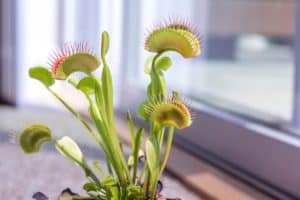
Description
The Venus Flytrap, without hesitation, is the most famous carnivorous plant, and the plant grows from a bulblike rootstock, with which it carries a cluster of small white flowers at the apex of an 8 to12 inches (20 to 30 cm) tall erect stem. The leaves are 3 to 6 inches long (8 to15 cm) and have hinged blades along the midline, allowing the 2 roughly circular lobes, which have scaly teeth along their margins, to curl together and wrap an insect alighting on them.
Mechanism of action and digestion
Venus Flytraps use sweet nectar to attract their prey. When pressure is exacted on the six sensitive hairs (three on each lobe) by an insect or animal, it causes the two almost equal circular lobes to slam shut. For example, when stimulated by prey in normal daytime temperatures, the lobes snap shut in about 500 milliseconds. The leaf’s surface glands then naturally produce a red sap that digests the insect’s body and gives the whole leaf a red flowerlike visual effect. The digestion process takes about 10 days, after which the leaf reopens. After catching 3 or 4 insects, the trap dies.
Where to buy a Venus flytrap
Healthy Venus flytraps can be purchased on Amazon and plants purchased from specialist carnivorous plant nurseries are typically stronger and more resilient than those purchased from local nurseries or department stores.
Pitcher plant

Description
Pitcher plants have the appearance and smell of flowers and are shaped like vases or pitchers. This insect-eating plant differs in size, shape, color, and location based on the species, age, and amount of light they receive. Regardless of their differences, they are all perennials, which implies that the upper section of the plant dies each winter and regrows in the spring from the very same, established roots.
While some pitcher plant species have thrived, others are on the verge of extinction. The contributing factor that enhances the rate of their extinction is the introduction of invasive species, application of herbicides, and human habitat destruction.
Mechanism of action and digestion
Insects are attracted to the color, nectar, and scent of the flower of pitcher plants, and when they do so, they are trapped inside. After being trapped, the hairs and digestive acids within the plant prevent the insects from escaping, thereby becoming a meal for this plant that eats insects. The digestion and decomposition process of the insect is very slow and during the process of the digestion, the pitcher plant absorbs the vital nutrients from the insects into its own system for survival. This plant that eats animals relies on them for additional nutrients because the soil alone is insufficient to keep the plants healthy.
Habitat
Habitats differ based on if the pitcher plant is an American or a Tropical pitcher plant. Because the American pitcher plants thrive in nutrient-depleted soils and wetlands such as swamps, bogs, marshes, and fens. While the tropical pitcher plants are also commonly found near bodies of water, such as lake edges, riverbanks, and springs.
Diet
Small pitcher plants feed on ants, wasps, slugs, snails, and flies. While the larger pitcher plants feed on lizards, small frogs, or rodents.
Yellow pitcher plant
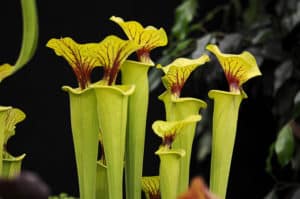
This tall southern pitcher plant is also known as the Sarracenia flava (a yellow pitcher) is characterized by a distinctive green trumpet with red veins. The nectar glands along the hood margins and throat of this insect-eating plant are extremely productive, thereby attracting a very large number of flying insects. The yellow pitcher plant thrives in wet bog soil, especially during spring when its traps are efficient and sturdier.
Cobra lily

Description
Within its genus, the Cobra Lily (Darlingtonia californica) is the only species. This insect-eating plant is indigenous to Southern Oregon and Northern California. This insect-eating plant is associated with other Sarracenia pitcher plants, but it has distinct physiological differences from them. This plant that eats animals is typically found at sea level along the Northern California and Southern Oregon coasts.
The cobra lily has an odd broad curved pitcher head that opens downward, and unlike other pitcher plants; this (the curved pitcher), combined with the sharp forked leaf at the plant’s mouth, gives the plant an unmistakable likeness to the renowned hooded snake from which it gets its name. Darlingtonia californica is a ravenous insectivore, and the physical features of the plants do not scare off the insects.
Traps
Cobra Lilies employ the same kind of pitfall trap tactics as traditional North American pitcher plants. These involve the use of nectar, sharp downward-pointing hairs that guide insects to the slick waxy surfaces, and red coloration.
The forked “tongue” dangling from the trap’s “mouth” has to be the most distinguishing feature of the Cobra Lily. This tongue secretes exhilarating nectar, with the highest concentrations found where the tongue meets the opening of the trap.
Mechanism of action and digestion
When a bug gets trapped inside the bulbous hood, it becomes mystified and therefore unable to find the exit because transparent blotches cover the “head” of the trap like tiny portholes (which also resemble scales). The exhausted bug stumbles and falls into the trap as a result of numerous failed attempts to escape through the false exists.
Unlike its relatives, the Cobra lily does not generate digestive enzymes but instead secretes water that drowns a bug and encourages bacteria and microorganisms to decompose soft tissues for absorption; similar to how our large intestines use beneficial bacteria in our microbiome to digest food.
Butterwort
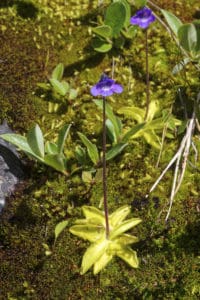
Description
Butterwort plants (Pinguicula) are small plants that go unnoticed until they bloom. It is a passive trapper plant, which means that it does not use movement to capture its prey. The leaves are soft and greenish-yellow in color, which most likely inspired the name. It could also be because the leaves have a slightly greasy or buttery feel to them. In the spring, the plant forms low rosettes and blooms with yellow, pink, purple, or white flowers. There are short hairs on the leaves of butterworts (seen at the base of the lower leaf) that secrete sticky mucilage.
The leaves of this insect-eating plant are coated in an insect-attracting resin. For example, gnats are the preferred prey for these tiny plants because they are easily attracted to the plants and they provide valuable nitrogen for the plant to use. Butterworts leaves are all at the plant’s base, oval to nearly round, and frequently curled up at the edges. The plant’s upper surface is constantly sticky, and tiny flies like mosquitoes, gnats, and midges easily and quickly conform to it.
On the surface of the leaf, there are two glands, namely, the stalked glands and the short surface glands. The stalked glands are sticky, and they trap the insect. While the digestive enzymes, like phosphatases, proteases, and ribonuclease, are provided by the short surface glands, which then resorb the digested material.
When learning how to grow butterworts, it is important to consider the site conditions. These plants that eat animals prefer alkaline soil with low nutrients and a warm, moist – boggy environment.
Mechanism of action and digestion
This plant-eating insect’s trapping mechanism is straightforward. Insects get entangled in the sticky mucilage (which they may mistake for water or nectar). When an insect becomes entangled in the mucilage, the leaf’s edge slowly rolls over, but the leaves never fully close.
After the digestion of the meal (insect), the leaf edges unroll and the leaf nearly flattens.
Monkey cup
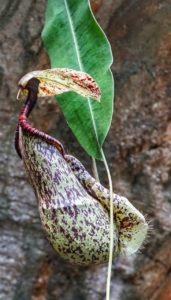
Description
The monkey cup plant is a Southeast Asian and Australian native carnivorous plant, that grows pitchers (cups) which hang from trees. Its cup is comparable to that of the North American pitcher plant in that it traps its prey in a pool of water. It has a leaf that begins as a normal leaf, before developing a tendril (This is a tiny and slim threadlike or whiplike strand that grows from the node of a stem and allows a vine or other plant to climb. Its anatomy can be made up of stem tissue or leafstalk tissue) at its tip, and finally developing an amazing pitcher at the tip of the tendril. It gains strength by wrapping the tendril around another plant. The trap, like our own pitcher plant, entices its prey into the pitfall trap with a combination of decaying odors and, occasionally, a red coloration. Because of its weight, the pitcher swells and droops as it grows.
Mechanism of action and digestion
When the pitcher is inflated, it begins to fill with liquid before opening to reveal the enticing interior. The lid on top of the trap initially covers the cups until growth is complete. The lid opens and the trap is ready when the leaf is fully grown. With the odor of nectar, they attract insects, and once inside, the insect discovers that it can’t get a grip on the pitcher’s walls because a flaky wax on the interior surface peels off as it tries to climb. It eventually falls into the water and struggles to get out. The movement caused by the struggle stimulates digestive glands, causing them to release digestive acid. This acid is so potent that a midge will vanish within hours.
After the decomposition of the meal by the digestive acid, larvae of insects feed on the decaying remains of prey. Other tiny insects live in the upper levels and descend every now and then to seize one of the larval inhabitants. In one case, the plant creates a chamber in its stem for ants to live in. As the ants go into the cups, they take some of the decaying prey and sit on the pitcher’s lip to dismember it. As they disassemble the body, fragments fall back into the pitcher’s waiting pool, where the now smaller fragments decay faster than a whole insect.
Drosera

Description
Drosera (sundew), known as the master of sticky flypaper which is a slower trap than the one in Venus Flytrap.
This plant that eats animals is called sundews because of its glandular leaf hairs that glisten like dew in the sun. The sundews are not only found in bogs but can also be found on sandy banks and other mineral soils deficient in organic nitrogen and phosphorus. This tiny plant is so fascinating that Darwin (1875) spent 285 pages of his book on insectivorous plants explaining his own studies with it.
Mechanism of action and digestion
This insect-eating plant acts by first trapping its prey with its sticky, glandular hairs, before slowly rolling up the edges of the leaf. It does not fold like the Venus flytrap, but the numerous hairs can effectively enclose small flies. The hairs on the sundews are stalked glands that secrete digestive juices that aid in the decomposition of the trapped prey. Once prey is captured, the production of digestive enzymes such as protease and phosphatase increases, reaching a peak around the fourth day.
Utricularia
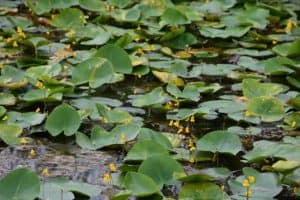
Description
Utricularia, also known as bladderwort, is a plant named after its miniature (small or tiny) bladders, or utricles. Unlike the other carnivorous plants. Bladderwort frequently lives in open water, but only in areas with a low nutrient concentration with a common habitat being nutrient-depleted bog lakes. This plant that eats bugs supplements its nutrients in open water by trapping insects in a bladder that resembles a suction bulb.
Mechanism of action and digestion
At the opening of the bladder of these plants that eat animals are pretty small hairlike projections that are sensitive to the movement of passing organisms such as Daphnia (water fleas). The stimulation of the hairs on this aquatic plant that eats insects causes the sudden inflation of the flattened bladder, thereby sucking in water and the passing animal before finally closing the trap door behind it.
Facts about carnivorous plants
- There are over 700 different species of carnivorous plants on the planet: Carnivorous plants can be found on all seven continents (except Antarctica).
- Venus Fly Traps catch their prey using a snap trap: Most people associate carnivorous plants with the Venus Fly Trap. Its leaves are divided in half and have spikes on the ends to aid in the formation of a seal. When a fly, ant, or other bug gets between the leaves, they snap shut in less than a second. They also catch a lot of spiders because spiders are attracted to other dead insects.
- Pitcher plants collect their food using a pitfall trap: The simplicity of pitcher plants’ mechanism hints at how carnivorous plants evolved in the first place. It’s easy to understand: they have hollow leaves filled with water and digestive acids. Any insects or prey that fall into the water drown and are slowly digested. Some of these have waxy leaves that make it easier for bugs to fall in, while others have chemicals that reduce the surface tension of the water.
- To catch insects, some plants employ active sticky traps: For example, sundews have tentacles on their leaves that cling to insects that land on them. When an insect lands on it, its movement causes other tentacles to close in on it, suffocating it to death. The bug is then slowly digested by the plant over time.
- Others employ what is known as passive sticky traps: Other plants have sticky traps as well, but they aren’t activated actively. They’re more akin to the sticky mouse traps you might keep in your garage. When an insect with these tiny, sticky tentacles lands on plants, they become stuck. The plant then secretes digestive acids to liquefy and digest the insect. The butterwort is the most common plant that employs the passive sticky trap method.
- Suction traps are awe-inspiring to watch: This is most likely the most interesting type of trap. Suction traps can be found on bladderworts and are fascinating to watch in action. In microseconds, they suck in bugs and other prey (literally faster than you can blink twice). Their favorite food is mosquito larva, but the largest suction traps can capture small tadpoles by the tail and eat them from the bottom up.
- Prey is captured underground by the lobster pot trap: This is most likely the most unusual trap on the list. This plant’s roots are hollow with little openings along the length of them, giving it the nickname “lobster pot trap” because it resembles fishing for those delicious crustaceans. When little bugs and larvae crawl into the roots, they are forced to go inside by sharp hairs positioned in the direction of the plant’s stomach.
- New carnivorous plant species are being discovered: New species of carnivorous plants are being unearthed all the time. In fact, a bromeliad species has recently been found to be in the process of evolving to become carnivorous. Scientists believe this because the leaves are wax-coated and encourage bugs to fall into water-filled pitchers (similar to pitcher plants). Whether it’s the discovery of new carnivorous species or the evolution of plants to become carnivorous, these plants aren’t going away anytime soon.
- Some carnivorous plants do not use digestive enzymes at all: Plants do not even require digestive enzymes to be classified as carnivorous. Some of them form alliances with beneficial bacteria and direct their growing energy toward physical traps instead.
- The majority of carnivorous plants live in areas with poor soil nutrition: Although carnivorous plants can be found in other climates, the majority are found in swamps, bogs, marshes, or other wet and soggy areas. Because there isn’t much nutrition in the soil in these areas, it’s possible that they’ve evolved to rely on insects and other living creatures for nutrition.
- Underwater, there are carnivorous plants: There aren’t many carnivorous plants underwater, but one is well-known: the Waterwheel Plant or Aldrovanda. These plants feed on mosquito larvae and are essentially underwater Venus Fly Traps.
- Deserts contain carnivorous plants: In dry, arid areas, there are a few carnivorous plants, for example, the Drosophyllum, which grows in Morocco and Spain, is one such plant. Because the soil is deficient in nutrients, it has evolved to use sticky traps to kill and capture bugs. Drosophyllum has the ability to trap insects as large as bees.
- If you want to grow carnivorous plants, you should invest in a greenhouse: If you intend to keep and grow carnivorous plants, you should be aware that they are found all over the world and require specific climates to thrive. A greenhouse is the best way to accomplish this. If you’re just getting started, you probably don’t need one, just get a species that is not too selective about its climate.
- If you can’t afford a greenhouse, a terrarium will suffice: If you are into growing and caring for insectivorous plants but don’t have enough money for a greenhouse, you could consider a terrarium if you want to cultivate a plant that has specific climate requirements. You can control humidity, soil, temperature, water, and everything else they require to survive in a good terrarium.
- Take NO carnivorous plants from the wild: If you happen to come across carnivorous plants while out for a walk in the woods, don’t take them. It’s tempting, but people removing these plants from their natural habitats are the reason why so many of them are now listed as endangered.
- Rather, purchase them from reputable nurseries or online retailers: Instead of collecting wild plants, purchase them from nurseries, greenhouses, or online retailers. If you’re just getting started, you can even get some at your local Home Depot.